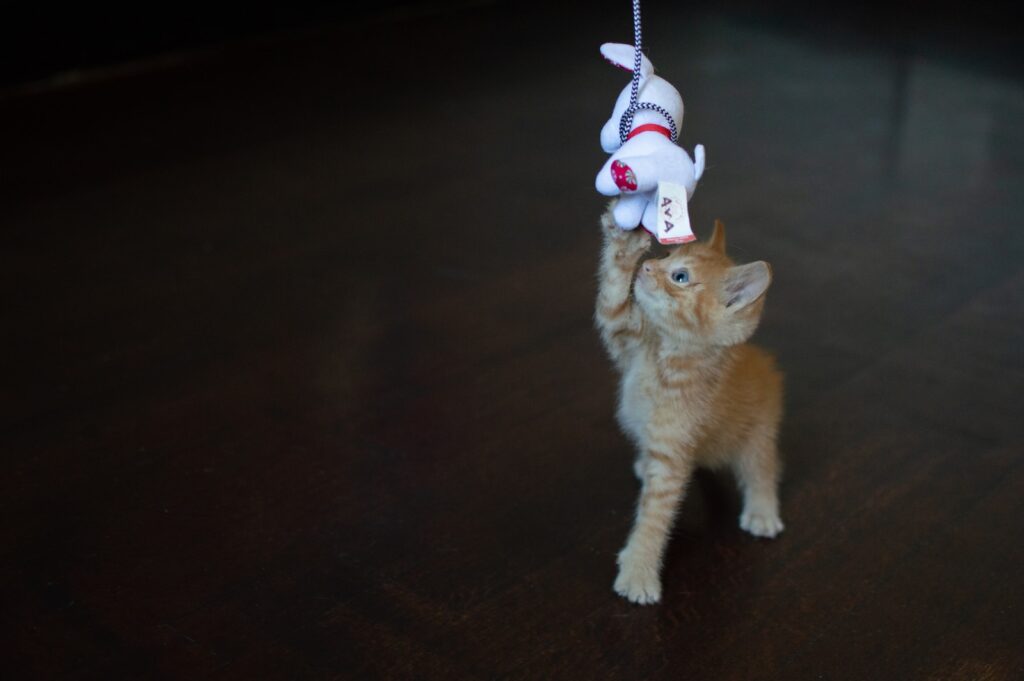Ever noticed your indoor cat attempting a playful pounce on thin air? Or perhaps lost in a deep, contemplative gaze at seemingly nothing? These actions are your cat’s way of letting you know they’re itching for some action. But don’t stress, because we’re about to embark on a feline-filled journey into the world of indoor cat amusement.
Interactive Toys and Gadgets
Playing with toys isn’t just fun for cats; it’s an essential part of their daily routine. Not only do toys keep them mentally stimulated, but they also provide an excellent way for them to exercise and keep fit.
Laser Pointers
Transform any ordinary space into a feline sports ground with a simple laser pointer. The erratic movement of that tiny red dot can captivate any cat, making them leap, dash, and pounce in exhilaration. However, it’s crucial to ensure the laser never points directly into their eyes. The sheer joy of watching your cat chase after that ever-elusive dot? Absolutely unbeatable!
Feather Wands
A feathery, fluttering wand isn’t just a toy; for your cat, it’s a mock prey. The unpredictable nature of a feather wand, darting and diving, mimics the movements of birds, triggering their innate hunting instincts. It’s a fun and interactive way for owners and cats to bond while also indulging the feline’s predatory habits safely indoors.
Robotic Mice
Why rely on traditional toys when modern technology offers so much more? Robotic mice, with their lifelike scuttles and pauses, provide a near-authentic hunting experience. It’s a fascinating watch as your cat stalks, pounces, and swats, utterly entranced by the gadget.
Puzzle Feeders
Combining food with fun? Yes, please! Puzzle feeders make your cat think, strategize, and work for their meal, ensuring they’re mentally stimulated during feeding time. It’s a brilliant method to slow down speedy eaters while also adding a playful element to their daily routine.
Vertical Spaces
Anyone who’s observed cats knows they have an affinity for heights. This tendency isn’t just a quirky preference; it’s deeply rooted in their nature.
Cat Trees
An almost mandatory addition for cat enthusiasts, cat trees are multifunctional marvels. They give your cat the height they crave, serve as perfect scratching posts, and even offer comfy napping spots. Multi-tiered trees are especially beneficial for homes with multiple cats, ensuring everyone has their perch.
Floating Shelves
Who said shelves are strictly for inanimate decor? By setting up floating shelves at varying heights, you create an exciting vertical playground for your cat. They can jump, climb, and lounge, all while keeping a watchful eye over their territory.
Window Seats
Offer your cat a front-row seat to the world’s best entertainment: nature. A window seat provides them with endless hours of bird-watching, leaf-chasing, and even the occasional squirrel-spotting. It’s a passive yet thoroughly engaging activity for your indoor feline.
Hammocks
Imagine a cozy, suspended cradle that sways slightly with movement. For cats, a hammock isn’t just a resting place; it’s a luxurious experience. Whether it’s by the window, under a table, or attached to a radiator, hammocks are a hit among the feline crowd.
Foraging Activities
In the wild, cats rely on their sharp instincts and wit to hunt for food. While indoor cats have their meals provided, the primal urge to forage remains. By introducing foraging activities, you can satisfy this innate drive in a fun, stimulating manner.
Hidden Treats
Make every day feel like a treasure hunt for your feline friend by hiding treats in different corners of your home. Watching your cat sniff, search, and finally discover these edible gems is both entertaining and rewarding for them.
Treat Dispensing Balls
These clever toys are designed to reward physical activity. As your cat rolls the ball, treats are occasionally dispensed, offering a tasty incentive to keep playing. Not only do they satisfy the foraging instinct, but they also provide physical exercise.
DIY Forage Box
A simple cardboard box can become an exciting forage site with a little creativity. Fill it with crumpled paper, toys, and some hidden treats. Your cat will have a blast digging through and discovering the hidden treasures.
Catnip
This natural herb is like magic for many cats. Sprinkle a bit of catnip on a toy, scratching post, or even the floor, and watch your usually composed feline become utterly playful. However, it’s essential to use it in moderation to prevent desensitization.
Training Sessions
While cats have a reputation for being independent, that doesn’t mean they can’t be trained. In fact, training sessions can be a great way to mentally stimulate your cat and strengthen your bond with them.
Clicker Training
Clicker training, typically associated with dogs, works wonders for cats too. Using a small device that makes a clicking sound, you can teach your cat various commands and tricks. Every time they perform the desired action, a click is sounded followed by a treat. Over time, your cat associates the click with positive behavior.
Agility Training
Set up a feline obstacle course in your living room using boxes, tunnels, and jumps. Train your cat to navigate through this course, encouraging them with treats and praises. It’s a fantastic way for your cat to exercise both their body and mind.
Fetch
Believe it or not, some cats enjoy playing fetch just as much as dogs do. Throw a lightweight ball or toy and watch as your feline friend dashes to retrieve it. With positive reinforcement, this can become a fun routine activity.
Leash Training
If you ever wanted to take your indoor cat out for a stroll, leash training is the answer. With patience and the right harness, you can teach your cat to walk on a leash, allowing them to safely explore the outdoors under your supervision.
Social Interaction
While often pegged as solitary creatures, many cats actually thrive on social interaction, be it with their human companions, other felines, or even different pets. Let’s delve into the myriad ways you can satiate your feline’s social appetite.
Playdates
If you have friends or neighbors with friendly cats, consider organizing a playdate. Just like kids, cats can benefit from interacting with their own kind. They can play, chase, or just laze around in each other’s company. However, it’s crucial to introduce them slowly and ensure both cats are comfortable with the arrangement.
Adopt a Companion
If you’ve been contemplating getting another pet, it might be a good idea. Having two cats can be doubly delightful. They can play, groom, and nap together, keeping each other entertained and reducing feelings of loneliness when you’re not around.
Human Time
Never underestimate the power of quality time between you and your kitty. Whether it’s playing with a toy, cuddling on the couch, or simply talking to them, your cat cherishes these moments. It strengthens the bond and provides emotional satisfaction.
Watching Videos
Modern technology has even catered to our feline friends. There are numerous videos available online specifically designed for cats. These videos often feature birds, fish, or insects moving about, capturing your cat’s attention. Play one on your TV or tablet, and watch your cat become a curious viewer.
DIY Toys
Store-bought toys are great, but sometimes, the best toys are the ones made at home with love. Here are some easy DIY options to consider.
Paper Balls
As simple as it sounds, a crumpled ball of paper can be an exciting toy for a cat. They can bat it around, chase it, and even carry it in their mouths. Plus, it’s an economical way to provide entertainment.
Cardboard Forts
Cardboard boxes aren’t just for packing. With a bit of imagination, they can transform into magnificent forts or castles for your cat. Cut out some windows or doors and watch your cat enjoy their new fortress.
Sock Toys
Don’t throw away those old socks! Fill one with some catnip or a small bell, tie the end, and voilà! You have a soft, enticing toy that your cat will adore.
T‑shirt Tents
Using some old t‑shirts and a few hangers or cardboard, you can fashion a cozy little tent for your cat. It’s a snug spot for them to relax and even play in.
Grooming and Pampering
Just like us, cats love to be pampered. A grooming session isn’t just about maintaining their appearance; it’s also a therapeutic bonding activity.
Brushing
Regular brushing not only keeps your cat’s fur smooth and tangle-free but also offers a gentle massage. Many cats enjoy the sensation and even purr in contentment during these sessions.
Cat Massages
Yes, you read that right. Cats too can benefit from a gentle massage. Softly kneading their muscles, especially along the spine and neck, can help them relax and even improve circulation.
Water Play
Contrary to popular belief, not all cats hate water. Some actually enjoy splashing around in shallow trays or tubs. If your cat seems curious, introduce them to water play, ensuring it’s a safe and positive experience.
Safe Outdoor Time
If you have a secure balcony or garden, consider letting your cat out for short supervised spells. They can bask in the sun, feel the breeze, and get a taste of the outside world without the associated risks.
Conclusion
When it comes to entertaining our feline friends, it’s crucial to recognize that every cat is unique, each possessing its own set of likes and dislikes. With a blend of patience, observation, and creativity, you can craft a delightful mix of activities and toys to keep your indoor cat engaged, healthy, and happy. Whether through modern gadgets, DIY solutions, or simple human interaction, the aim is to tap into their innate instincts and desires. And remember, sometimes it’s the simplest gestures that evoke the loudest purrs and the most heartfelt kneads.
FAQs
- Q: Are laser pointers safe for cats?
A: Absolutely. Laser pointers can be an excellent toy, stimulating a cat’s hunting instincts. However, always ensure you never shine the laser directly into their eyes. Also, give your cat a tangible reward after playtime to avoid frustration from never “catching” the dot.
- Q: How often should I play with my indoor cat?
A: Regular interaction is essential for your cat’s mental and physical well-being. Ideally, engaging in daily play sessions, each lasting around 10–15 minutes, is beneficial. However, this can vary based on the cat’s age, health, and personality.
- Q: Can too much catnip be harmful?
A: While catnip is generally safe and enjoyed by many cats, moderation is key. Excessive exposure can result in a cat becoming desensitized to it, meaning they might not react as strongly in the future. Always monitor your cat’s reaction and ensure it’s a positive experience for them.
- Q: Are all cats trainable?
A: While cats are more independent than dogs, many can be trained using the right techniques. Patience, positive reinforcement, and understanding your cat’s individual temperament are crucial factors in successful training.
- Q: What if my cat doesn’t like any of the toys?
A: Cats, being the unique creatures they are, might not always take to every toy or game you introduce. It’s essential to be observant and flexible. If a particular toy doesn’t seem to interest your cat, try another. Also, remember that sometimes the simplest things, like a cardboard box or a crumpled paper ball, can bring immense joy.






